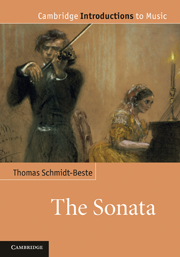Chapter 1 - Definitions
Published online by Cambridge University Press: 05 April 2013
Summary
Everyone who plays a musical instrument has come across sonatas, and certain composers and particular works spring most readily to mind. Pianists are likely to think of Beethoven (perhaps also Haydn, Mozart, Brahms, Liszt); organists, of J. S. Bach (and perhaps Mendelssohn); violinists – depending on whether they are more interested in earlier or later periods – of Corelli and Vivaldi or of (again) Mozart and Beethoven, possibly also of Brahms and César Franck. The list continues with composers who may be less familiar to the general public than to instrumentalists: again J. S. Bach for viol players, Quantz and Poulenc for flautists, perhaps Brahms for clarinettists and Paul Hindemith for violists.
Those who have studied music theory in school or elsewhere will also be reminded of ‘sonata form’ – that elusive combination of exposition, development and recapitulation that has allegedly informed instrumental music since the late eighteenth century but that seems to consist more of exceptions than of rules. And of course: even if we could confidently define ‘sonata form’, sonatas were composed in abundance even before its advent. Giovanni Gabrieli composed ensemble sonatas as early as the late sixteenth century; Arcangelo Corelli's and Henry Purcell's trio sonatas are considered to be paradigmatic of Baroque instrumental style and texture. However, the only feature they share with the classical sonata is the fact that they consist (most frequently) of four movements; these movements follow their own traditions of texture, form and style, and the description of such works as ‘dance suites’ or ‘church sonatas’ is almost as fraught with ambiguities as the dreaded ‘sonata form’ itself.
- Type
- Chapter
- Information
- The Sonata , pp. 1 - 19Publisher: Cambridge University PressPrint publication year: 2011

